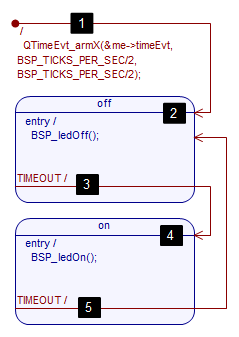The ultra-simple Blinky example is the embedded systems' equivalent of the venerable "Hello World!" program, that is, the simplest possible working QP application that does "something". In the case of Blinky, this "something" is blinking an LED at the rate of 1Hz, where an LED turns on and remains on for 0.5 seconds on then turns off and remains off for 0.5 seconds.

The ultra-simple Blinky application, which consists of just one active object named Blinky, is intentionally kept small and illustrates only the most basic QP features, such as:
The very simple state machine of the Blinky AO is shown in the figure below:

1 The top-most initial transition in this state machine arms a QP time event (QTimeEvt_armX()) to deliver the TIMEOUT signal every half second, so that the LED can stay on for one half second and off for the other half.
2 The initial transition leads to state "off", which turns the LED off in the entry action (BSP_ledOff()).
TIMEOUT event arrives in the "off" state, the "off" state transitions to the "on" state BSP_ledOn()). TIMEOUT event arrives in the "on" state, the "on" state transitions back to "off", which cases execution of the entry action, in which the LED is turned off. From that point on the cycle repeats forever because the TIMEOUT events keep getting generated at the pre-determined rate. The Blinky state machine shown above is implemented in the blinky.c source file, as shown in the listing below. The code has been specifically organized not to access target resources directly, but instead encapsulate all such access in the calls to the BSP (Board Support Package). So for example, instead of turning the LED on and off by writing to a specific GPIO register on an embedded board, the code calls the BSP functions BSP_ledOn() and BSP_ledOff(). These functions can then be defined differently for each Target board (or even a desktop workstation), without the need to change the state machine code.
As you can see, the structure of the state machine is very clearly recognizable in this code. Please refer to the Application Note A Crash Course in UML State Machines for exact explanation of the state machine coding techniques.